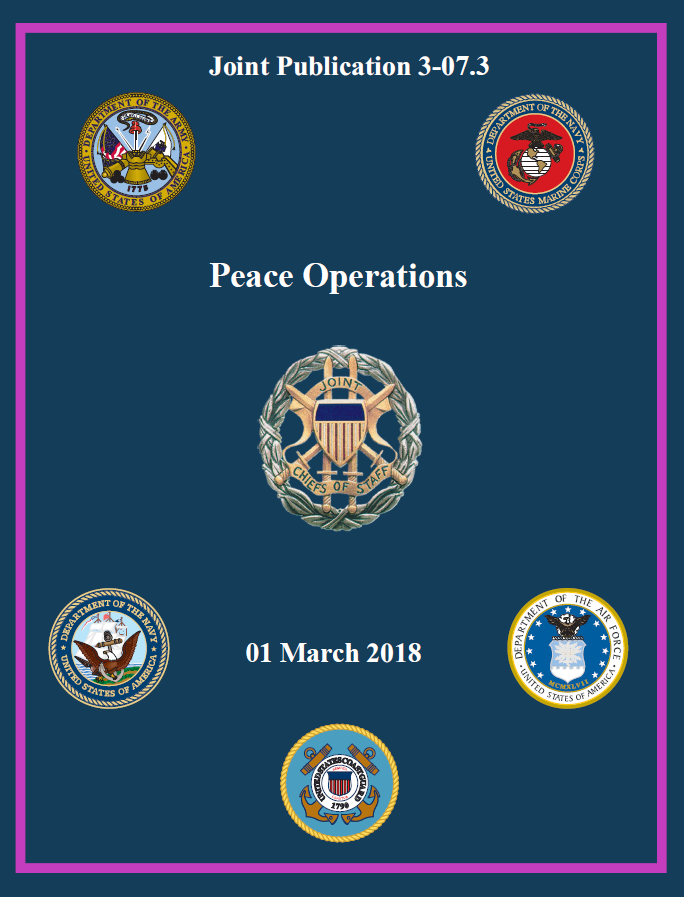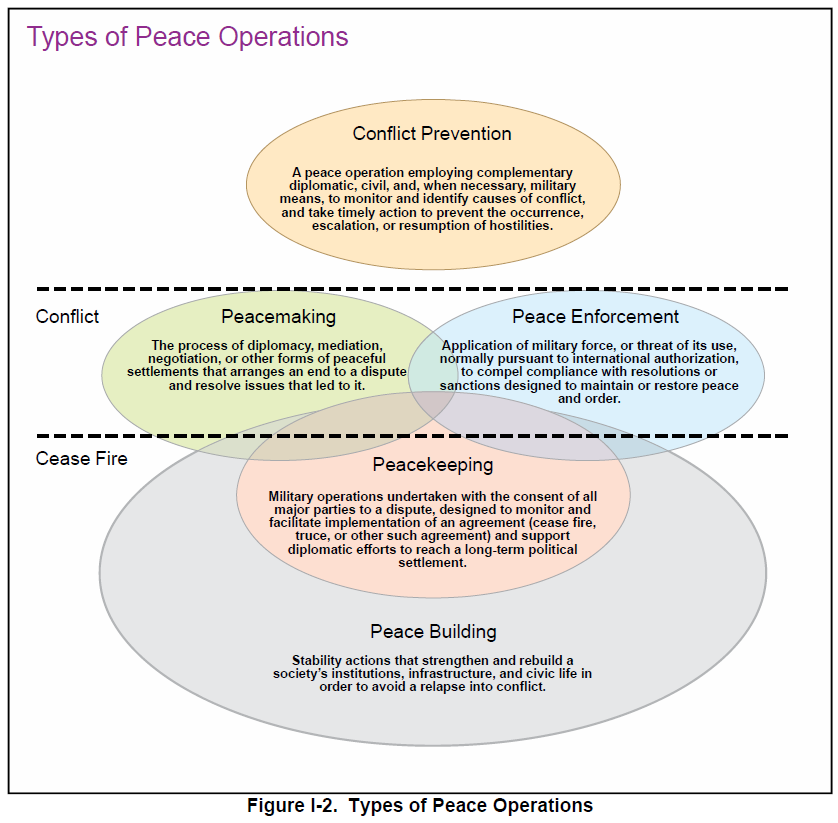Peace operations are activities intended to build, keep, enforce, or make peace, or when necessary, prevent conflict. They include crisis response and limited contingency operations and frequently involve international military missions to contain conflict, restore peace, and shape the strategic security environment to support reconciliation and rebuilding, as well as to facilitate the transition to legitimate governance. They include peacekeeping operations (PKO), peace building, peacemaking, conflict prevention, and peace enforcement operations (PEO). Peace operations may be conducted under the sponsorship of the United Nations (UN), another international organization, within a coalition of nations, or unilaterally.
…
1. Introduction
a. Peace operations are activities intended to build, keep, enforce, or make peace, or when necessary, prevent conflict. They include crisis response and limited contingency operations and frequently involve international military missions to contain conflict, restore peace, and shape the strategic security environment to support reconciliation and rebuilding, as well as to facilitate the transition to legitimate governance. They include peacekeeping operations (PKO), peace building, peacemaking, conflict prevention, and peace enforcement operations (PEO). Peace operations may be conducted under the sponsorship of the United Nations (UN), another international organization, within a coalition of nations, or unilaterally. The UN and other international organizations often refer to a peace operations organization as a mission.
b. The global demand for peace operations is growing. These efforts can be effective and legitimate mechanisms that demonstrate international support while sharing the requisite burden. Peace operations can also be an important theme for multinational exercises and other joint force security cooperation (SC) activities to build relationships with partner nations for which peacekeeping is a strategic priority.
c. The US provides support for peace operations through three lines of effort:
(1) Direct contributions with funding, personnel, units, or other support.
(2) Indirect contributions including building the capability and capacity of other contributors to peace operations.
(3) Support for systemic reform in the UN to improve the effectiveness of peace operations.
d. As with all military operations, each peace operation is unique, reflecting the political, military, economic, social, information, and infrastructure characteristics of the operational environment (OE).
2. Legal Basis
a. The US may conduct peace operations either independently or as part of an international or multinational effort. In some cases, the UN may authorize a peace operation by a coalition or another international organization such as the North Atlantic Treaty Organization (NATO) or the African Union (AU).
b. The Charter of the United Nations and Statute of the International Court of Justice, herein referred to as the UN Charter, provides several means for the international community to address threats to peace and security. Although the terms “peacekeeping” and “peace enforcement” are not in the UN Charter, they generally describe actions taken under Chapter VI (Pacific Settlement of Disputes) and Chapter VII (Action with Respect to Threats to the Peace, Breaches of the Peace, and Acts of Aggression) in the UN Charter. Chapter VI of the UN Charter addresses peaceful means of establishing or maintaining peace through negotiation, enquiry, arbitration, conciliation, judicial settlement, and mediation, while Chapter VII provides the United Nations Security Council (UNSC) with a wide range of enforcement actions—from diplomatic and economic measures to the extensive application of armed force by member nations.
c. Under Chapter VIII (Regional Arrangements) of the UN Charter, the UN may authorize regional organizations such as NATO, the Organization of American States (OAS), the AU, the Economic Community of West African States, and the European Union (EU) to prevent, halt, or contain conflict in their respective regions.
d. Additionally, some nations have negotiated multilateral agreements to conduct peace operations independent of any permanent international forum. However, such operations have usually taken place with the tacit approval of a regional organization or the UN.
…


